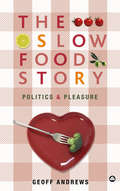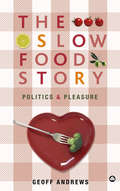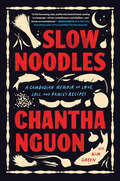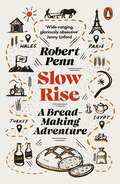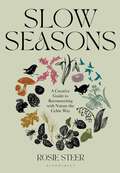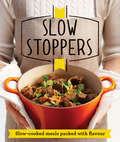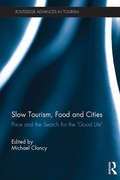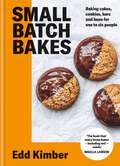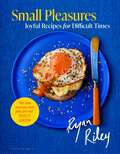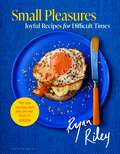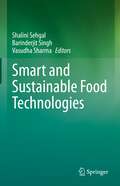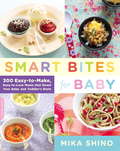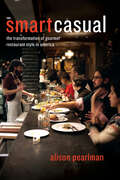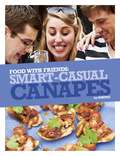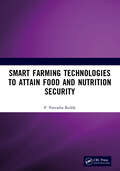- Table View
- List View
The Slow Food Story: Politics and Pleasure
by Geoff AndrewsThe Slow Food movement was set up in Italy as a response to the dominance of fast food chains, supermarkets and large-scale agribusiness. It seeks to defend what it calls 'the universal right to pleasure' and promotes an alternative approach to food production and consumption based on the promotion of 'good, clean and fair' local products.*BR* *BR*This is the first in-depth study of the fascinating politics of Slow Food, which in twenty years has grown into an international organisation with more than 80,000 members in over 100 countries. With its roots in the 1960s and 1970s counter-culture, Slow Food's distinctive politics lie in the unity between gastronomic pleasure and environmental responsibility. The movement crosses the left-right divide to embrace both the conservative desire to preserve traditional rural communities and an alternative 'virtuous' idea of globalisation.*BR* *BR*Geoff Andrews shows that the alternative future embodied in Slow Food extends to all aspects of modern life. The Slow Food Story presents an extensive new critique of fast-moving, work-obsessed contemporary capitalist culture.
The Slow Food Story: Politics and Pleasure
by Geoff AndrewsThe Slow Food movement was set up in Italy as a response to the dominance of fast food chains, supermarkets and large-scale agribusiness. It seeks to defend what it calls 'the universal right to pleasure' and promotes an alternative approach to food production and consumption based on the promotion of 'good, clean and fair' local products.*BR* *BR*This is the first in-depth study of the fascinating politics of Slow Food, which in twenty years has grown into an international organisation with more than 80,000 members in over 100 countries. With its roots in the 1960s and 1970s counter-culture, Slow Food's distinctive politics lie in the unity between gastronomic pleasure and environmental responsibility. The movement crosses the left-right divide to embrace both the conservative desire to preserve traditional rural communities and an alternative 'virtuous' idea of globalisation.*BR* *BR*Geoff Andrews shows that the alternative future embodied in Slow Food extends to all aspects of modern life. The Slow Food Story presents an extensive new critique of fast-moving, work-obsessed contemporary capitalist culture.
Slow Noodles: A Cambodian Memoir of Love, Loss, and Family Recipes
by Chantha NguonA haunting and beautiful memoir from a Cambodian refugee who lost her country and her family during Pol Pot's genocide in the 1970s but who finds hope by reclaiming the recipes she tasted in her mother's kitchen. RECIPE: HOW TO CHANGE CLOTH INTO DIAMONDTake a well-fed nine-year-old with a big family and a fancy education. Fold in 2 revolutions, 2 civil wars, and 1 wholesale extermination. Subtract a reliable source of food, life savings, and family members, until all are gone. Shave down childhood dreams for approximately two decades, until only subsistence remains. In Slow Noodles, Chantha Nguon recounts her life as a Cambodian refugee who loses everything and everyone—her home, her family, her country—all but the remembered tastes and aromas of her mother&’s kitchen. She summons the quiet rhythms of 1960s Battambang, her provincial hometown, before the dictator Pol Pot tore her country apart and killed more than a million Cambodians, many of them ethnic Vietnamese like Nguon and her family. Then, as an immigrant in Saigon, Nguon loses her mother, brothers, and sister and eventually flees to a refugee camp in Thailand. For two decades in exile, she survives by cooking in a brothel, serving drinks in a nightclub, making and selling street food, becoming a suture nurse, and weaving silk. Nguon&’s irrepressible spirit and determination come through in this lyrical memoir that includes more than twenty family recipes such as sour chicken-lime soup, green papaya pickles, and pâté de foie, as well as Khmer curries, stir-fries, and handmade bánh canh noodles. Through it all, re-creating the dishes from her childhood becomes an act of resistance, of reclaiming her place in the world, of upholding the values the Khmer Rouge sought to destroy, and of honoring the memory of her beloved mother, whose &“slow noodles&” approach to healing and cooking prioritized time and care over expediency.Slow Noodles is an inspiring testament to the power of food to keep alive a refugee&’s connection to her past and spark hope for a beautiful life.
Slow Rise: A Bread-Making Adventure
by Robert PennCharming, important ... a journey of discovery - TelegraphOver the course of a year, Robert Penn learns how to plant, harvest, thresh and mill his own wheat, in order to bake bread for his family. In returning to this pre-industrial practice, he tells the fascinating story of our relationship with bread: from the domestication of wheat in the Fertile Crescent at the dawn of civilization, to the rise of mass-produced loaves and the resurgence in homebaking today.Gathering knowledge and wisdom from experts around the world - farmers on the banks of the Nile, harvesters in the American Midwest and Parisian boulangers - Penn reconnects the joy of making and eating bread with a deep appreciation for the skill and patience required to cultivate its key ingredient. This book is a celebration of the millennia-old craft of breadmaking, and how it is woven into the story of humanity.
Slow Seasons: A Creative Guide to Reconnecting with Nature the Celtic Way
by Rosie Steer'A truly beautiful book. Rosie's writing makes me want to close my laptop, step outside, and appreciate the magic that each season brings' Jessica Elliot DennisonIn her late-twenties, feeling utterly overwhelmed by the pace of modern city life, Rosie Steer found solace in the traditions she had been brought up with, influenced by her Scottish roots, that celebrated nature and observed the small steady shifts in the seasons.The Celtic Wheel of the year is an ancient seasonal cycle that aligns with solar events – the solstices, equinoxes and their midpoints. For each mini-season, Rosie shares nature notes for what we can look out for as the days get warmer or cooler, the nights longer or shorter, alongside activities, things to make, flowers or fruit to forage, seasonal recipes to enjoy and a modern take on the traditional celebrations.As the Wheel turns towards Samhain on 31st October, we can look forward to foraging apples and berries to make Hedgerow jelly, watching the leaves turn golden, collecting pine cones for a Pine cone garland and celebrating pumpkin season with Pumpkin and root veg chilli and Chocolate cake with pumpkin curd.By slowing down and paying attention to the ebbs and flows of nature, we can find moments of calm whenever we need them.
Slow Seasons: A Creative Guide to Reconnecting with Nature the Celtic Way
by Rosie Steer'A truly beautiful book. Rosie's writing makes me want to close my laptop, step outside, and appreciate the magic that each season brings' Jessica Elliot DennisonIn her late-twenties, feeling utterly overwhelmed by the pace of modern city life, Rosie Steer found solace in the traditions she had been brought up with, influenced by her Scottish roots, that celebrated nature and observed the small steady shifts in the seasons.The Celtic Wheel of the year is an ancient seasonal cycle that aligns with solar events – the solstices, equinoxes and their midpoints. For each mini-season, Rosie shares nature notes for what we can look out for as the days get warmer or cooler, the nights longer or shorter, alongside activities, things to make, flowers or fruit to forage, seasonal recipes to enjoy and a modern take on the traditional celebrations.As the Wheel turns towards Samhain on 31st October, we can look forward to foraging apples and berries to make Hedgerow jelly, watching the leaves turn golden, collecting pine cones for a Pine cone garland and celebrating pumpkin season with Pumpkin and root veg chilli and Chocolate cake with pumpkin curd.By slowing down and paying attention to the ebbs and flows of nature, we can find moments of calm whenever we need them.
Slow Stoppers: Slow-cooked Meals Packed With Flavour
by Good Housekeeping InstituteGood Housekeeping recipes tick all the boxes –They look greatThey taste deliciousThey’re easy to make
Slow Tourism, Food and Cities: Pace and the Search for the "Good Life" (Routledge Advances in Tourism)
by Michael ClancySlow Food began in the late 1980s as a response to the spread of fast food establishments and as a larger statement against globalization and the perceived deterioration of modern life. Since then, slow practices have permeated into other areas, including cities and territories and travel and tourism. This book provides an in-depth examination of slow food, tourism and cities, demonstrating how these elements are intertwined with one other as part of the modern search for "the good life." Part 1 locates the slow concept within the larger social setting of modernity and investigates claims made by the slow movement, examining aesthetic and instrumental values inherent to it. Part 2 explores the practices and places of slow, containing both conceptual and empirical chapters in Italy, the birthplace of the movement. Part 3 provides a comparative perspective by examining the practices in Spain, the UK, Germany and Canada. Slow Tourism, Food and Cities offers key theoretical insights and alternative perspectives on the varying practices and meanings of slow from a cultural, sociological and ethical perspective. It is a valuable text for students and scholars of sociology, geography, urban studies, social movements, travel and tourism, and food studies.
Slow Tourism, Food and Cities: Pace and the Search for the "Good Life" (Routledge Advances in Tourism)
by Michael ClancySlow Food began in the late 1980s as a response to the spread of fast food establishments and as a larger statement against globalization and the perceived deterioration of modern life. Since then, slow practices have permeated into other areas, including cities and territories and travel and tourism. This book provides an in-depth examination of slow food, tourism and cities, demonstrating how these elements are intertwined with one other as part of the modern search for "the good life." Part 1 locates the slow concept within the larger social setting of modernity and investigates claims made by the slow movement, examining aesthetic and instrumental values inherent to it. Part 2 explores the practices and places of slow, containing both conceptual and empirical chapters in Italy, the birthplace of the movement. Part 3 provides a comparative perspective by examining the practices in Spain, the UK, Germany and Canada. Slow Tourism, Food and Cities offers key theoretical insights and alternative perspectives on the varying practices and meanings of slow from a cultural, sociological and ethical perspective. It is a valuable text for students and scholars of sociology, geography, urban studies, social movements, travel and tourism, and food studies.
Small Batch Bakes: Baking cakes, cookies, bars and buns for one to six people (Edd Kimber Baking Titles)
by Edd Kimber'The book that every home baker - including me! - needs' - Nigella LawsonBaking recipes typically serve large groups, which is perfect for a party, a celebration or a crowd, but not when there's just one or two of you and you would rather not spend the money on making a big batch, or be faced with eating leftovers for a week. Following on from the huge success of One Tin Bakes and One Tin Bakes Easy, Great British Bake Off winner Edd Kimber's new book proves that good things really do come in small packages! It offers accessible, easy bakes that are perfect for singles, small households, students or anyone who likes to bake a lot. Primarily sweet, the recipes include cookies, cakes, tarts and bars a well as desserts and a sprinkling of savoury breads, buns and pies. The skill level is on the easier side, and equipment is kept to a minimum, so everyone can have a little of what they fancy.
Small Pleasures: Joyful Recipes for Difficult Times
by Ryan Riley"Ryan Riley's recipes deliver bold flavour and deep comfort: this is a book that nourishes both body and soul." - Nigella LawsonWhether you're recovering from an illness, or running low on mood, time, energy, money or headspace, Ryan Riley has the easy and delicious recipes to minimise the work and maximise the flavour and perk yourself up. No matter how you're feeling, do something enjoyable for yourself and beat the January blues with Ryan Riley's small pleasures: simple, delicious bites packed full of Life Kitchen's signature flavours to revive your love of food. These are recipes high in flavour for low times, to nourish and heal, with the added bonus of using ingredients that are naturally gut-friendly. This is Ryan's manifesto to feeling better and falling back in love with food: first you have recipes for comfort, for when eating is a chore but these recipes are the first steps in the roadmap to feeling more yourself; then comes restoration, with recipes to reawaken your senses; and the final chapter, pleasure, is all about indulgence, a love letter to yourself as you return to the world. Take some time for self-care in the kitchen with these simple and surprising recipes – new favourites that you didn't know you were searching for. These are can-do recipes for when you feel like you can't. From marmite jacket potatoes or 5-ingredient miso tomato sauce to green herbs and 'nduja frittata and gochujang, ginger and avocado toast, the 80+ simple recipes are all easily scalable, so no matter your mood or appetite, there is something in these pages to help you rediscover the joy of food. These are small pleasures with big flavours.
Small Pleasures: Joyful Recipes for Difficult Times
by Ryan Riley"Ryan Riley's recipes deliver bold flavour and deep comfort: this is a book that nourishes both body and soul." - Nigella LawsonWhether you're recovering from an illness, or running low on mood, time, energy, money or headspace, Ryan Riley has the easy and delicious recipes to minimise the work and maximise the flavour and perk yourself up. No matter how you're feeling, do something enjoyable for yourself and beat the January blues with Ryan Riley's small pleasures: simple, delicious bites packed full of Life Kitchen's signature flavours to revive your love of food. These are recipes high in flavour for low times, to nourish and heal, with the added bonus of using ingredients that are naturally gut-friendly. This is Ryan's manifesto to feeling better and falling back in love with food: first you have recipes for comfort, for when eating is a chore but these recipes are the first steps in the roadmap to feeling more yourself; then comes restoration, with recipes to reawaken your senses; and the final chapter, pleasure, is all about indulgence, a love letter to yourself as you return to the world. Take some time for self-care in the kitchen with these simple and surprising recipes – new favourites that you didn't know you were searching for. These are can-do recipes for when you feel like you can't. From marmite jacket potatoes or 5-ingredient miso tomato sauce to green herbs and 'nduja frittata and gochujang, ginger and avocado toast, the 80+ simple recipes are all easily scalable, so no matter your mood or appetite, there is something in these pages to help you rediscover the joy of food. These are small pleasures with big flavours.
Smart and Sustainable Food Technologies
by Shalini Sehgal Barinderjit Singh Vasudha SharmaThis book presents a comprehensive view of emerging smart technologies in various food processing sectors. Specifically, it covers smart technologies applied in food production, food manufacturing, food packaging, storage, distribution, and food supply chain. Contributing authors are the key scientists with diverse backgrounds in either industry or academia.The book contains four parts with four chapters each, presenting recent smart technologies developed in their respective areas. Part I primarily focuses on the recent smart food production innovations such as precision agriculture, vertical farming, automation, robotics , livestock technology, modern greenhouse practices, artificial intelligence, and block chain that dramatically increase the quality of raw materials for the food industry. Part II provides the current knowledge and developments related to the recent smart technologies in manufacturing pertaining to various food sectors, non-thermal food preservation technologies, and 3D printing, developed for the food manufacturing industries that improve the organoleptic and nutritional quality, enhance chemical and microbial safety, as well as cost-effectiveness and convenience of processed foods. Part III covers smart technologies to ensure food safety in the supply chain, with monitoring and surveillance of food contamination, use of IoT and blockchain for food traceability and neural network approach for risk assessment. Part IV provides expert opinions on using smart technologies for minimizing waste and maximizing co-product recovery in food processing; upcycling technologies in food and sustainable value stream mapping in the food industry.This book will be a useful resource to graduate/undergraduate students and researchers in advanced food technology, practicing technologists/engineers in the food and related industries, food packaging industry, entrepreneurs and other scientists and technologists in smart and sustainable processes who seek information on design and development of these processes.
Smart Bites for Baby: 300 Easy-to-Make, Easy-to-Love Meals that Boost Your Baby and Toddler's Brain
by Mika ShinoEven though we know that babies and children learn primarily through their senses, American babies are still eating mushy food from a jar--at a time when their brains are growing exponentially and they are most open to trying new things. Smart Bites for Baby offers a better approach to cooking for babies and toddlers. Drawing on world cuisine, this cookbook includes 300 easy recipes made with nutrient-rich ingredients, such as fish, berries, and sesame. The meals emphasize color, texture, and flavor, and are proven to engage and stimulate the growing brain. Parents will also find more nutritious versions of the foods toddlers love, from mac n&’ cheese to popsicles. Shino&’s smart bites nourish the minds and bodies of our children.
Smart Casual: The Transformation of Gourmet Restaurant Style in America
by Alison PearlmanFine dining and the accolades of Michelin stars once meant chandeliers, white tablecloths, and suited waiters with elegant accents. The stuffy attitude and often scant portions were the punchlines of sitcom jokes—it was unthinkable that a gourmet chef would stoop to plate a burger or a taco in his kitchen. And yet today many of us will queue up for a seat at a loud, crowded noodle bar or eagerly seek out that farm-to-table restaurant where not only the burgers and fries are organic but the ketchup is homemade—but it’s not just us: the critics will be there too, ready to award distinction. Haute has blurred with homey cuisine in the last few decades, but how did this radical change happen, and what does it say about current attitudes toward taste? Here with the answers is food writer Alison Pearlman. In Smart Casual: The Transformation of Gourmet Restaurant Style in America, Pearlman investigates what she identifies as the increasing informality in the design of contemporary American restaurants. By design, Pearlman does not just mean architecture. Her argument is more expansive—she is as interested in the style and presentation of food, the business plan, and the marketing of chefs as she is in the restaurant’s floor plan or menu design. Pearlman takes us hungrily inside the kitchens and dining rooms of restaurants coast to coast—from David Chang’s Momofuku noodle bar in New York to the seasonal, French-inspired cuisine of Alice Waters and Thomas Keller in California to the deconstructed comfort food of Homaro Cantu’s Moto in Chicago—to explore the different forms and flavors this casualization is taking. Smart Casual examines the assumed correlation between taste and social status, and argues that recent upsets to these distinctions have given rise to a new idea of sophistication, one that champions the omnivorous. The boundaries between high and low have been made flexible due to our desire to eat everything, try everything, and do so in a convivial setting. Through lively on-the-scene observation and interviews with major players and chefs, Smart Casual will transport readers to restaurants around the country to learn the secrets to their success and popularity. It is certain to give foodies and restaurant-goers something delectable to chew on.
Smart Casual: The Transformation of Gourmet Restaurant Style in America
by Alison PearlmanFine dining and the accolades of Michelin stars once meant chandeliers, white tablecloths, and suited waiters with elegant accents. The stuffy attitude and often scant portions were the punchlines of sitcom jokes—it was unthinkable that a gourmet chef would stoop to plate a burger or a taco in his kitchen. And yet today many of us will queue up for a seat at a loud, crowded noodle bar or eagerly seek out that farm-to-table restaurant where not only the burgers and fries are organic but the ketchup is homemade—but it’s not just us: the critics will be there too, ready to award distinction. Haute has blurred with homey cuisine in the last few decades, but how did this radical change happen, and what does it say about current attitudes toward taste? Here with the answers is food writer Alison Pearlman. In Smart Casual: The Transformation of Gourmet Restaurant Style in America, Pearlman investigates what she identifies as the increasing informality in the design of contemporary American restaurants. By design, Pearlman does not just mean architecture. Her argument is more expansive—she is as interested in the style and presentation of food, the business plan, and the marketing of chefs as she is in the restaurant’s floor plan or menu design. Pearlman takes us hungrily inside the kitchens and dining rooms of restaurants coast to coast—from David Chang’s Momofuku noodle bar in New York to the seasonal, French-inspired cuisine of Alice Waters and Thomas Keller in California to the deconstructed comfort food of Homaro Cantu’s Moto in Chicago—to explore the different forms and flavors this casualization is taking. Smart Casual examines the assumed correlation between taste and social status, and argues that recent upsets to these distinctions have given rise to a new idea of sophistication, one that champions the omnivorous. The boundaries between high and low have been made flexible due to our desire to eat everything, try everything, and do so in a convivial setting. Through lively on-the-scene observation and interviews with major players and chefs, Smart Casual will transport readers to restaurants around the country to learn the secrets to their success and popularity. It is certain to give foodies and restaurant-goers something delectable to chew on.
Smart Casual: The Transformation of Gourmet Restaurant Style in America
by Alison PearlmanFine dining and the accolades of Michelin stars once meant chandeliers, white tablecloths, and suited waiters with elegant accents. The stuffy attitude and often scant portions were the punchlines of sitcom jokes—it was unthinkable that a gourmet chef would stoop to plate a burger or a taco in his kitchen. And yet today many of us will queue up for a seat at a loud, crowded noodle bar or eagerly seek out that farm-to-table restaurant where not only the burgers and fries are organic but the ketchup is homemade—but it’s not just us: the critics will be there too, ready to award distinction. Haute has blurred with homey cuisine in the last few decades, but how did this radical change happen, and what does it say about current attitudes toward taste? Here with the answers is food writer Alison Pearlman. In Smart Casual: The Transformation of Gourmet Restaurant Style in America, Pearlman investigates what she identifies as the increasing informality in the design of contemporary American restaurants. By design, Pearlman does not just mean architecture. Her argument is more expansive—she is as interested in the style and presentation of food, the business plan, and the marketing of chefs as she is in the restaurant’s floor plan or menu design. Pearlman takes us hungrily inside the kitchens and dining rooms of restaurants coast to coast—from David Chang’s Momofuku noodle bar in New York to the seasonal, French-inspired cuisine of Alice Waters and Thomas Keller in California to the deconstructed comfort food of Homaro Cantu’s Moto in Chicago—to explore the different forms and flavors this casualization is taking. Smart Casual examines the assumed correlation between taste and social status, and argues that recent upsets to these distinctions have given rise to a new idea of sophistication, one that champions the omnivorous. The boundaries between high and low have been made flexible due to our desire to eat everything, try everything, and do so in a convivial setting. Through lively on-the-scene observation and interviews with major players and chefs, Smart Casual will transport readers to restaurants around the country to learn the secrets to their success and popularity. It is certain to give foodies and restaurant-goers something delectable to chew on.
Smart Casual: The Transformation of Gourmet Restaurant Style in America
by Alison PearlmanFine dining and the accolades of Michelin stars once meant chandeliers, white tablecloths, and suited waiters with elegant accents. The stuffy attitude and often scant portions were the punchlines of sitcom jokes—it was unthinkable that a gourmet chef would stoop to plate a burger or a taco in his kitchen. And yet today many of us will queue up for a seat at a loud, crowded noodle bar or eagerly seek out that farm-to-table restaurant where not only the burgers and fries are organic but the ketchup is homemade—but it’s not just us: the critics will be there too, ready to award distinction. Haute has blurred with homey cuisine in the last few decades, but how did this radical change happen, and what does it say about current attitudes toward taste? Here with the answers is food writer Alison Pearlman. In Smart Casual: The Transformation of Gourmet Restaurant Style in America, Pearlman investigates what she identifies as the increasing informality in the design of contemporary American restaurants. By design, Pearlman does not just mean architecture. Her argument is more expansive—she is as interested in the style and presentation of food, the business plan, and the marketing of chefs as she is in the restaurant’s floor plan or menu design. Pearlman takes us hungrily inside the kitchens and dining rooms of restaurants coast to coast—from David Chang’s Momofuku noodle bar in New York to the seasonal, French-inspired cuisine of Alice Waters and Thomas Keller in California to the deconstructed comfort food of Homaro Cantu’s Moto in Chicago—to explore the different forms and flavors this casualization is taking. Smart Casual examines the assumed correlation between taste and social status, and argues that recent upsets to these distinctions have given rise to a new idea of sophistication, one that champions the omnivorous. The boundaries between high and low have been made flexible due to our desire to eat everything, try everything, and do so in a convivial setting. Through lively on-the-scene observation and interviews with major players and chefs, Smart Casual will transport readers to restaurants around the country to learn the secrets to their success and popularity. It is certain to give foodies and restaurant-goers something delectable to chew on.
Smart Casual: The Transformation of Gourmet Restaurant Style in America
by Alison PearlmanFine dining and the accolades of Michelin stars once meant chandeliers, white tablecloths, and suited waiters with elegant accents. The stuffy attitude and often scant portions were the punchlines of sitcom jokes—it was unthinkable that a gourmet chef would stoop to plate a burger or a taco in his kitchen. And yet today many of us will queue up for a seat at a loud, crowded noodle bar or eagerly seek out that farm-to-table restaurant where not only the burgers and fries are organic but the ketchup is homemade—but it’s not just us: the critics will be there too, ready to award distinction. Haute has blurred with homey cuisine in the last few decades, but how did this radical change happen, and what does it say about current attitudes toward taste? Here with the answers is food writer Alison Pearlman. In Smart Casual: The Transformation of Gourmet Restaurant Style in America, Pearlman investigates what she identifies as the increasing informality in the design of contemporary American restaurants. By design, Pearlman does not just mean architecture. Her argument is more expansive—she is as interested in the style and presentation of food, the business plan, and the marketing of chefs as she is in the restaurant’s floor plan or menu design. Pearlman takes us hungrily inside the kitchens and dining rooms of restaurants coast to coast—from David Chang’s Momofuku noodle bar in New York to the seasonal, French-inspired cuisine of Alice Waters and Thomas Keller in California to the deconstructed comfort food of Homaro Cantu’s Moto in Chicago—to explore the different forms and flavors this casualization is taking. Smart Casual examines the assumed correlation between taste and social status, and argues that recent upsets to these distinctions have given rise to a new idea of sophistication, one that champions the omnivorous. The boundaries between high and low have been made flexible due to our desire to eat everything, try everything, and do so in a convivial setting. Through lively on-the-scene observation and interviews with major players and chefs, Smart Casual will transport readers to restaurants around the country to learn the secrets to their success and popularity. It is certain to give foodies and restaurant-goers something delectable to chew on.
Smart Casual: The Transformation of Gourmet Restaurant Style in America
by Alison PearlmanFine dining and the accolades of Michelin stars once meant chandeliers, white tablecloths, and suited waiters with elegant accents. The stuffy attitude and often scant portions were the punchlines of sitcom jokes—it was unthinkable that a gourmet chef would stoop to plate a burger or a taco in his kitchen. And yet today many of us will queue up for a seat at a loud, crowded noodle bar or eagerly seek out that farm-to-table restaurant where not only the burgers and fries are organic but the ketchup is homemade—but it’s not just us: the critics will be there too, ready to award distinction. Haute has blurred with homey cuisine in the last few decades, but how did this radical change happen, and what does it say about current attitudes toward taste? Here with the answers is food writer Alison Pearlman. In Smart Casual: The Transformation of Gourmet Restaurant Style in America, Pearlman investigates what she identifies as the increasing informality in the design of contemporary American restaurants. By design, Pearlman does not just mean architecture. Her argument is more expansive—she is as interested in the style and presentation of food, the business plan, and the marketing of chefs as she is in the restaurant’s floor plan or menu design. Pearlman takes us hungrily inside the kitchens and dining rooms of restaurants coast to coast—from David Chang’s Momofuku noodle bar in New York to the seasonal, French-inspired cuisine of Alice Waters and Thomas Keller in California to the deconstructed comfort food of Homaro Cantu’s Moto in Chicago—to explore the different forms and flavors this casualization is taking. Smart Casual examines the assumed correlation between taste and social status, and argues that recent upsets to these distinctions have given rise to a new idea of sophistication, one that champions the omnivorous. The boundaries between high and low have been made flexible due to our desire to eat everything, try everything, and do so in a convivial setting. Through lively on-the-scene observation and interviews with major players and chefs, Smart Casual will transport readers to restaurants around the country to learn the secrets to their success and popularity. It is certain to give foodies and restaurant-goers something delectable to chew on.
Smart Casual Canapés
by The Sorted Crew Ben EbbrellSmart-Casual Canapés is the third chapter from The Sorted Crew's new cookbook, Food with Friends.Things seem so much more sophisticated when translated into French, but while the word canapé sounds pretty classy, these bite-sized appetisers are actually just finger food. The real trick is to make them look as posh as they sound, so each canapé in this chapter is stupidly simple to make, but when you put four or five together they look really impressive. Recipes include: Jerk Chicken Potato Wedges, Mango, Coriander and Crayfish Sticks, Micro Jackets with Guacamole and Tequila Salmon Gravadlax.Food with Friends is the second cookbook from The Sorted Crew, with recipes by Ben Ebbrell. It's the ultimate guide for entertaining friends in a fun and fuss-free way, from romantic suppers and family barbecues to curry nights for hungry hordes. Whether you're cooking for two or twenty, Food with Friends by The Sorted Crew is THE book for easy entertaining.The Sorted Crew came together in their university holidays, sharing their cooking highs and lows with each other in the pub. Headed up by Ben Ebbrell and Barry Taylor, this original group of 8 mates with an interest in food has now grown into a highly engaged online community of hundreds of thousands, that works together to get food challenges sorted. The SortedFood video recipes on YouTube now get millions of views every month. They self-published two recipe books, A Recipe for Student Survival and A Rookie's Guide to Crackin' Cooking, and Beginners... Get Sorted was their first book with Penguin.
Smart Cookie: Transform Store-Bought Cookies Into Amazing Treats
by Christi JohnstoneIt's fun to bake, but it's really fun to decorate!Everyone knows the best part about making cookies is the decorating! Smart Cookie includes 50 simple and fun cookie creations made entirely from easy-to-find store-bought ingredients-no baking required! Projects include rainbows, monster pops, balloons, robots, ladybugs, and much more, with lots of ideas for tips, techniques, packaging, and displays.From birthdays to graduations and baby showers to Christmas, there is a cookie in this book for any and all occasions. If you love to decorate cookies, are looking for imaginative ways to celebrate holidays and special moments, this book is for you!
Smart Farming Technologies to Attain Food and Nutrition Security
by P. Parvatha ReddyThe concept of Rainbow Revolution is an integrated development of crop cultivation, horticulture, forestry, fishery, poultry, animal husbandry, and food processing industry. The concept of Smart Farming Technologies in agriculture is a step towards sustainability. India has already achieved resilience in agriculture, including the horticultural sector, through effective agricultural technology generation and is now on the threshold of a “rainbow revolution” that will ensure both household nutrition security and prosperity for its people. This book will be of immense value to the scientific community involved in teaching, research and extension activities related to strategies for achieving Rainbow Revolution for enhancing farmers’ income, food, and nutrition security. The book can also serve as a very useful reference for policymakers and practicing farmers.
Smart Farming Technologies to Attain Food and Nutrition Security
by P. Parvatha ReddyThe concept of Rainbow Revolution is an integrated development of crop cultivation, horticulture, forestry, fishery, poultry, animal husbandry, and food processing industry. The concept of Smart Farming Technologies in agriculture is a step towards sustainability. India has already achieved resilience in agriculture, including the horticultural sector, through effective agricultural technology generation and is now on the threshold of a “rainbow revolution” that will ensure both household nutrition security and prosperity for its people. This book will be of immense value to the scientific community involved in teaching, research and extension activities related to strategies for achieving Rainbow Revolution for enhancing farmers’ income, food, and nutrition security. The book can also serve as a very useful reference for policymakers and practicing farmers.
Smart Foods for ADHD and Brain Health: How Nutrition Influences Cognitive Function, Behaviour and Mood
by Rachel GowChanging one's diet not only improves physical health, but benefits mood, behaviour and cognitive function at a fundamental level. This book highlights the link between nutrition and mental health and demonstrates the crucial role of diet in supporting individuals with ADHD. Written by an internationally-recognised leader in the growing field of nutritional psychiatry, Dr Rachel Gow takes a nutrition-based look at ADHD and its management. Combining the latest research with the inspirational stories of a range of professionals and individuals whose lives have been touched by the issues raised, this book also includes accessible tips throughout and a chapter of recipes to promote brain health. This is an essential guide to understanding the interplay of brain health and nutrition, and supporting families to build a diet that optimises brain function and health.
